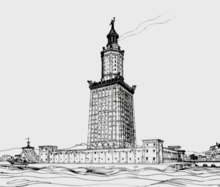Lighthouse of Alexandria

Drawing by archaeologist Hermann Thiersch (1909)
|
|
| Location | Pharos, Alexandria, Egypt |
|---|---|
| Coordinates | 31°12′50″N 29°53′08″E / 31.21389°N 29.88556°ECoordinates: 31°12′50″N 29°53′08″E / 31.21389°N 29.88556°E |
| Year first constructed | c. 280 BC |
| Deactivated | 1303/1323 |
| Foundation | Stone |
| Construction | Masonry |
| Tower shape | Square (below), octagonal (middle) and circular (top) |
| Height | 120–137 m (394–449 ft) |
| Range | 47 km (29 mi) |
The Lighthouse of Alexandria, sometimes called the Pharos of Alexandria (/ˈfɛərɒs/; Ancient Greek: ὁ Φάρος τῆς Ἀλεξανδρείας, contemporary Koine Greek pronunciation: [ho pʰá.ros teːs a.lek.sandréːaːs]), was a lighthouse built by the Ptolemaic Kingdom between 280 and 247 BC which was between 120 and 137 m (394 and 449 ft) tall. One of the Seven Wonders of the Ancient World, for many centuries it was one of the tallest man-made structures in the world. Badly damaged by three earthquakes between AD 956 and 1323, it then became an abandoned ruin. It was the third longest surviving ancient wonder (after the Mausoleum at Halicarnassus and the extant Great Pyramid of Giza) until 1480, when the last of its remnant stones were used to build the Citadel of Qaitbay on the site. In 1994, French archaeologists discovered some remains of the lighthouse on the floor of Alexandria's Eastern Harbour. The Ministry of State of Antiquities in Egypt has planned, as of late 2015, to turn submerged ruins of ancient Alexandria, including those of the Pharos, into an underwater museum.
Pharos was a small island located on the western edge of the Nile Delta. In 332 BC Alexander the Great founded the city of Alexandria on an isthmus opposite Pharos. Alexandria and Pharos were later connected by a mole spanning more than 1200 metres (.75 mi), which was called the Heptastadion ("seven stadia"—a stadium was a Greek unit of length measuring approximately 180 m). The east side of the mole became the Great Harbour, now an open bay; on the west side lay the port of Eunostos, with its inner basin Kibotos now vastly enlarged to form the modern harbour. Today's city development lying between the present Grand Square and the modern Ras al-Tiin quarter is built on the silt which gradually widened and obliterated this mole, and Ras al-Tiin represents all that is left of the island of Pharos, the site of the lighthouse at its eastern point having been weathered away by the sea.
...
Wikipedia
